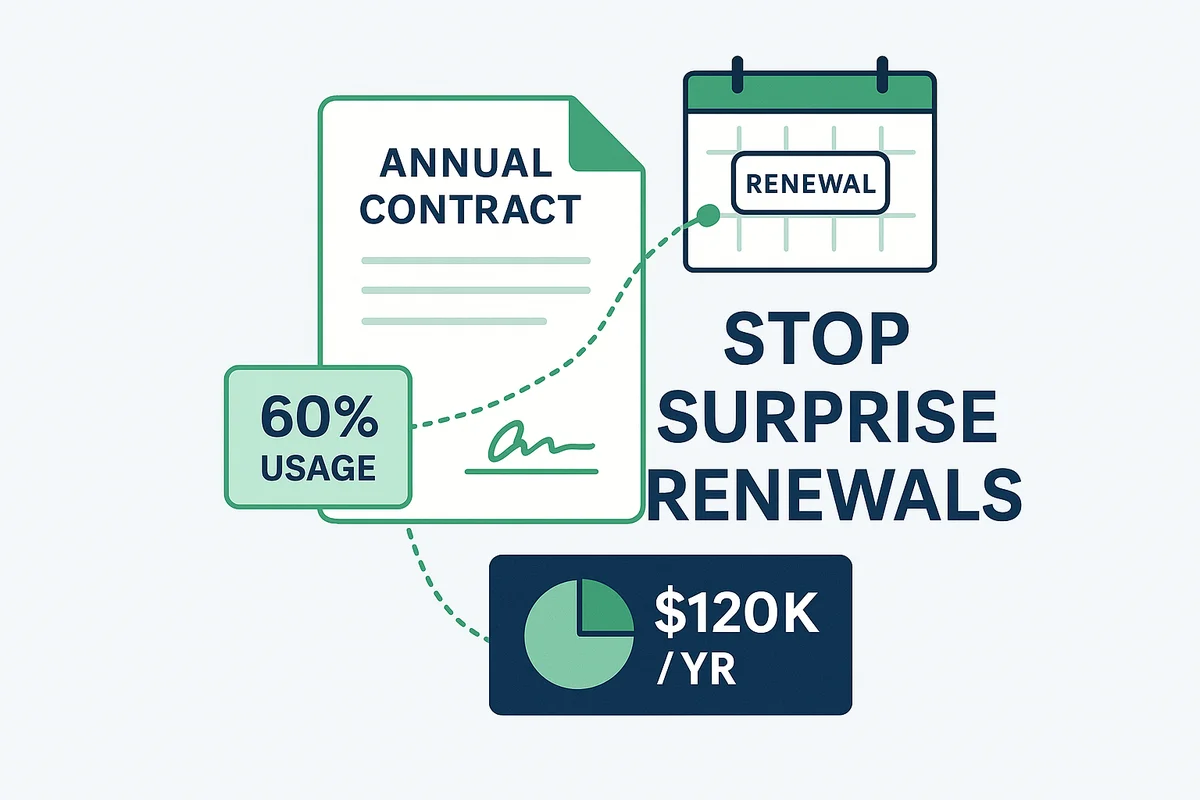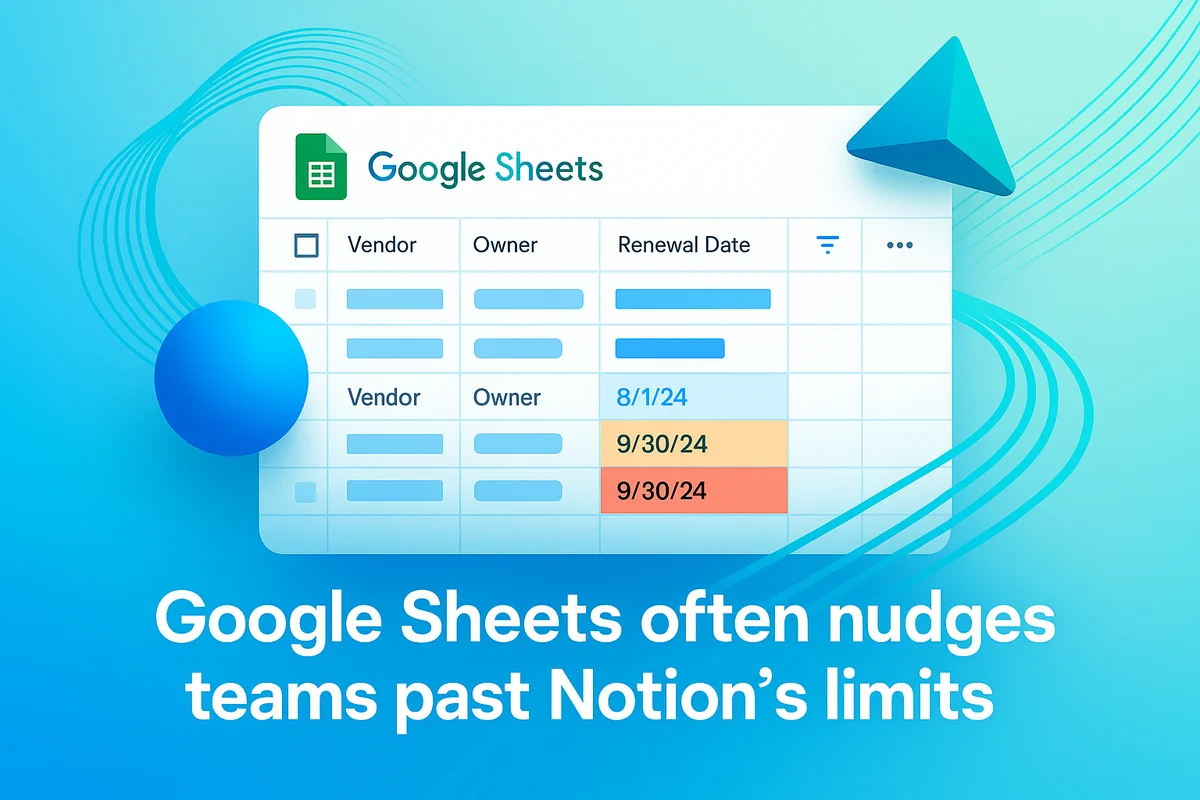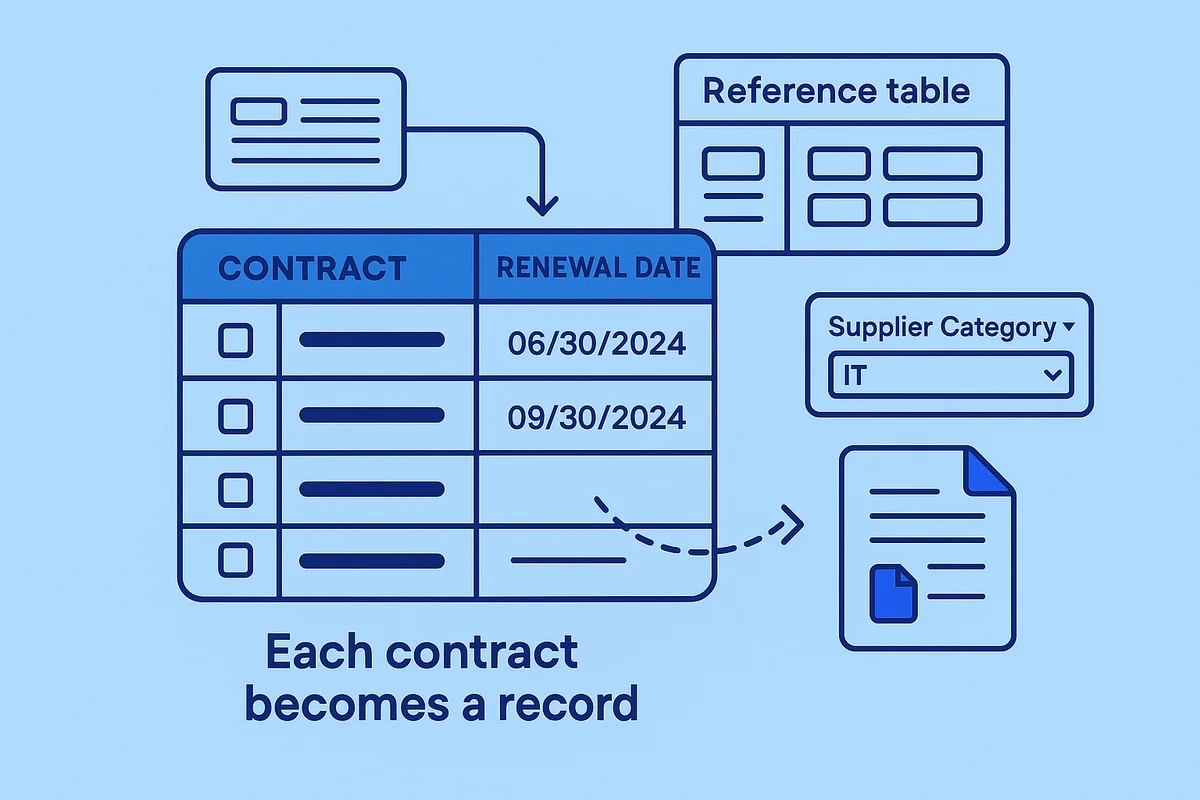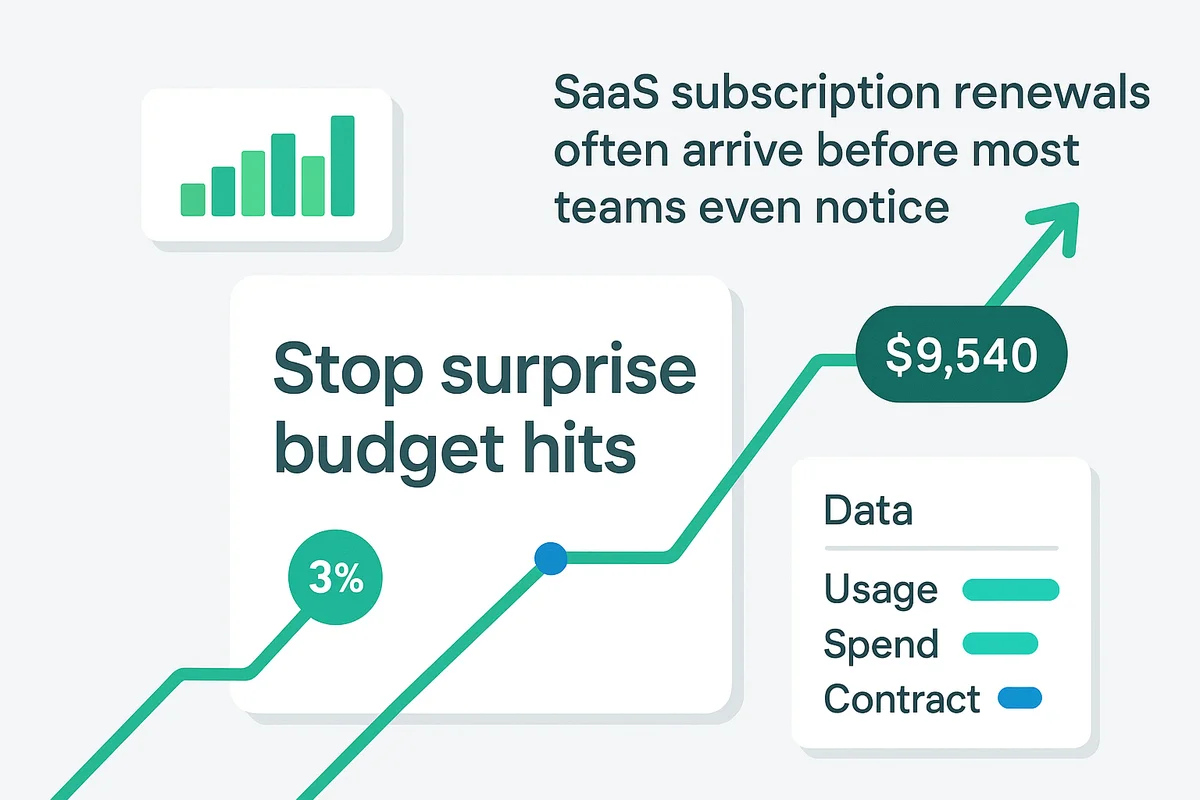3 Alternatives to Notion for Managing SaaS Contracts & Renewals
Every SaaS subscription you overlook drains budget and increases risk. Finance teams sift through line items while IT tallies seats, yet an auto-renewal still sneaks through. Once Notion tables hit their limit, leaders debate upgrading to a contract-lifecycle system or simply building a smarter sheet.
Renewal tooling lives on a spectrum, not a simple either-or chart. Fully automated SaaS hubs promise hands-off management, do-it-yourself Google Sheets keep costs low, and hybrids like Airtable split the difference. All three handle contract terms, renewal forecasts, and license cleanup, but each trades maintenance effort for analytical depth. Knowing which tasks demand automation and which tolerate manual steps prevents shelfware and surprise bills.
The next sections lay out those trade-offs in plain detail. You’ll see how dedicated SaaS platforms, Google Sheets, and Airtable cover approvals, reports, and spend visibility so you can match the tool to the job.
Table of Contents
- How do SaaS platforms automate renewals?
- How can Google Sheets manage renewals?
- How do Airtable and light CLMs track contracts?
- Conclusion
- Audit your company's SaaS usage today
How do SaaS platforms automate renewals?
Annual contracts tucked away in shared drives often renew on autopilot and quietly drain budgets. A solid SaaS management platform keeps an eye on them early and stops the surprise renewals.
These platforms start by pulling data you already have: signed PDFs from Google Drive, license counts from Okta, and spend records from NetSuite. An OCR engine tags renewal dates, payment terms, and pricing tiers, then a central calendar shows every upcoming notice window in one view. Zylo adds benchmark pricing so a renewal flagged for next month also shows how your rate stacks up against similar deals, turning a routine reminder into a negotiation head-start.
Teams pay attention when alerts pop up in tools they already use. Slack pings a contract owner 90 days out, while email nudges finance if projected spend exceeds a preset threshold. Seat usage feeds in daily; when use drops below, say, 60 percent, the platform marks those licenses “ripe for reclaim.” Single sign-on discovery means even apps purchased on an employee credit card appear in the dashboard, shrinking the shadow IT footprint without a scavenger hunt.
Renewal approvals no longer bounce around endless email threads internally. Workflow rules route a renewal over $25,000 to procurement, security, and legal in parallel, logging every sign-off for audits. During a SOC 2 review, the auditor clicks into the record, sees the signed agreement, penetration-test report, and access roster in one place, then moves on. What once took a week of evidence gathering now takes minutes.
Early data from SaaS-management rollouts looks almost too good to ignore:
- License reclaims typically cut unused seats 15 to 25 percent in the first quarter.
- Companies see up to 40 percent fewer “oops, it renewed” incidents after rolling out automated notices.
- Audit prep time drops by half because documents, usage logs, and approvals already live together.
The math is simple: a platform that costs five figures can pay for itself the first time it prevents a six-figure auto-renewal.

How can Google Sheets manage renewals?
Google Sheets often nudges teams past Notion’s limits without asking for extra licensing money or long onboarding. Finance or IT can copy a template, share the file, and everyone sees the same vendor grid within minutes. Filter views slice contracts by owner or renewal month, saving users from scrolling through hundreds of rows. With conditional formatting turning dates orange at 90 days and red at 30, upcoming expirations stand out before they turn costly. The learning curve rarely exceeds what people already know from daily spreadsheet work.
Sheets also fits neatly with the rest of the tech stack. An IMPORTRANGE pull can sync monthly spend from the accounting workbook, keeping totals current without manual copy-paste. Need real-time spend? Wrap SUMIF around IMPORTRANGE and totals adjust the moment accounting posts a new CSV. Simple Apps Script functions send renewal reminders each Monday morning or even draft a Google Doc purchase order from template fields. A controller at Snyk used a 30-line script to cut missed renewals by 60 percent in one quarter, proving that a handful of lines can replace pricey add-ons.
A clean layout matters, so start with columns that map to the procurement process.
- Vendor name
- Subscription owner
- Start date
- End date
- Auto-renew yes/no
- Seats purchased
- Monthly recurring cost
- Link to contract PDF
When every stakeholder works from the same list, approvals flow faster because finance, security, and legal no longer chase separate trackers.
Even so, Google Sheets will never babysit the data on its own. Seat counts stay accurate only when admins remember to update numbers after every onboarding or exit, and scripts fail quietly when someone renames a sheet. Larger teams often find version forks in personal drives, leaving finance to guess which file holds the truth. Without API hooks into Okta or Salesforce, usage insights remain a manual chore, so budget owners still spend an hour each month reconciling seats against invoices.

How do Airtable and light CLMs track contracts?
Database-style tools like Airtable and other lightweight “CLM-light” options such as ContractSafe give ops teams the structure Notion lacks. Each contract becomes a record with fields you choose, such as renewal date, early termination window, or supplier category, keeping information searchable instead of buried in text blocks.
Getting a basic setup running usually takes only a few hours. Choose a vendor-lifecycle template, import old PDFs, and let the CSV wizard map columns to rich field types. Forms then feed new purchase requests into the same base, while kanban or timeline views slice the database for finance, security, or IT without forcing each group to learn pivot tables.
Key wins surface once records link to each other or to reference tables holding budget owners and cost centers.
- Attachments sit next to metadata, so audits happen in one tab.
- Linked records show parent agreements, addendums, and SOWs without duplicating data.
- Filters spotlight contracts with auto-renew enabled and less than 60 days’ notice.
- Permission sets hide legal rates from casual viewers while still exposing renewal dates.
Even with these wins, the setup still needs regular attention. License counts rarely sync on their own, and uploading usage CSVs every quarter feels old after you’ve seen a SaaS management dashboard do it nightly. Native automations cap at a handful per base unless you pay for the Pro tier, which starts around twelve dollars a user each month. Heavy attachment storage pushes that amount higher. Teams eyeing advanced features such as OCR search, clause libraries, or approval workflows that post to Slack often realize they have entered the price band of full CLM suites without getting the same depth of functionality.

Conclusion
SaaS subscription renewals often arrive before most teams even notice. Dedicated platforms sift through usage, spend, and contract data, then alert the right stakeholders in time to stop waste. Google Sheets outmuscles Notion with formulas and scripts, yet someone still has to babysit the cells. Airtable and entry-level CLM tools supply relational views and intake forms, but advanced license feeds and automations sit behind higher paywalls.
Choose the stack that best blends automation, visibility, and price, and renewals stop being surprise budget hits.

Audit your company’s SaaS usage today
If you’re interested in learning more about SaaS Management, let us know. Torii’s SaaS Management Platform can help you:
- Find hidden apps: Use AI to scan your entire company for unauthorized apps. Happens in real-time and is constantly running in the background.
- Cut costs: Save money by removing unused licenses and duplicate tools.
- Implement IT automation: Automate your IT tasks to save time and reduce errors - like offboarding and onboarding automation.
- Get contract renewal alerts: Ensure you don’t miss important contract renewals.
Torii is the industry’s first all-in-one SaaS Management Platform, providing a single source of truth across Finance, IT, and Security.
Learn more by visiting Torii.
Frequently Asked Questions
SaaS platforms streamline renewal management by integrating data from multiple sources, setting alerts for stakeholders, and automating approval workflows, significantly reducing missed renewals and associated costs.
Yes, Google Sheets can effectively manage renewals by utilizing templates, formulas, and scripts to track expiration dates and sync data, though it requires regular updates for accuracy.
Airtable and similar tools provide organizational structure for contract data, allowing for easy tracking and searchable records, but require manual updates for license counts and may need paid upgrades for advanced features.
Overlooked SaaS subscriptions can drain budgets through unexpected auto-renewals, leading to wasted resources and surprise charges that could have been prevented with proper management.
Automated SaaS hubs provide hands-off management, reducing manual effort and human error compared to manual tracking methods like spreadsheets, which require constant oversight and can lead to inaccuracies.
Shelfware refers to software subscriptions that are paid for but not used. Effective management helps identify and eliminate these unnecessary expenses from the budget.
Tools that track renewals and usage provide alerts and insights, allowing companies to manage contract timelines proactively and minimize unexpected charges from auto-renewals.

